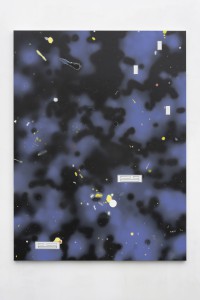In 2019 Event Horizon, a network of international telescopes, constructed the first image of a black hole. Since then millions of people throughout the world have seen this image. Astronomers involved in the project reported that there is an absence of time and space in black holes. This fact is inconceivable to human beings
The new paintings of Han Schuil can evoke a sense of timelessness ; the paintings invite us to enter a new reality, the reality of the world presented by the paintings. This is not about ‘understanding’ the realm of the paintings, not at all, nor is there any sense of this. The works are much more about an energetic feeling of clarity and an experience: an (almost) sacred moment of something that lies between the conscious and the unconscious. It’s not easy to get a grasp of the paintings made by Schuil. Perhaps that’s because they are observations of a subject or an environment that is not instantly fathomable. This is why they remain intriguing.
For Han Schuil, a variety of subject matter can serve as the basis for a painting. An advertisement, a striking image from the newspaper, or a thermogram. What’s important is that the painter is moved by the subject, that it prompts him to act. Prompts him to work. How do you give meaning to form, surface and color? How do you give meaning to a painting? Schuil has been spending decades pondering those fundamental questions about painting. In his work Schuil combines color, form and surface in order to create a new world of his own. The surface comes to life, and the new series of paintings teem with strength and energy. With new series Schuil underscores his long relationship and connection with the medium of painting and with the practice of painting.
Both movement and calm can be found among the different layers of the paintings. These layers communicate with and challenge each other within the work. Because of that current of communication, the works feel lively, as though it’s the material that moves and is contained at a certain point. The movement and the calm in the works are in balance with each other, and this gives rise to a coherent whole. The movement in the paintings goes in all sorts of directions, which makes it seem as though particles swarm about and, in other works, as though a shower of light passes through the paintings. The hushed quality, often the result of a dark ground layer, creates room for reflection and serves as a place where the viewer can pause, gather courage and then proceed with an exploration of the paintings. That frequently darkblue, nearly black ground layer in the works acts as an anchor for the eye.


Some paintings seem to have zoomed in on something from a great distance, concentrating on a source of light, while others that are zoomed out show a wider view. Aside from the movement and calm, there are also opposing degrees of relaxation and rigidity in the paintings. Rigidly formal elements, such as the white triangles, are alternated with looser and more informal components. These come together in a playful manner, while they each continue to hold their own strong positions within the painting. The two aspects clearly involve interaction as well as contrast.
The concentration of the paintings is fascinating, and all sorts of smaller things can be discovered on looking at them closely. A small area can be painted with so much precision, love and devotion that it represents a world unto itself. Layers of paint and spatters in black, blue, red, yellow, orange, purple and white tumble around and over each other. The paintings are full of things to be discovered at all sorts of sensory levels, but this never feels like an excess of information.
At best we forget about everything else on looking at the paintings; then it becomes a profound, almost meditative experience. Comparable, perhaps, to the spacelessness and timelessness of a black hole in the universe. A person is still not yet able to observe black holes, and probably never will be. In Amsterdam-Oost it is possible, though, at the Anton Pannekoek Institute for Astronomy to look at relatively nearby stars through a telescope. Planets, stars and cosmic phenomena are brimming with energy and seem special, while it is impossible to truly grasp and fathom them. A similar thing happens with these new paintings. There, at the Anton Pannekoek Institute, someone is trying, as far as this is possible, to describe what the viewer is looking at and what he or she might see. That person reaches out while also knowing very well that, just as with paintings by Schuil, the most important thing is to observe and experience it oneself.
text: Melchior Jaspers
translation: Beth O’Brien
Planciusstraat 7 1013 MD Amsterdam
t: +31 (0)20 420 2219 e: info@galerieonrust.nl www.galerieonrust.nl
OPENING HOURS
Friday-Saturday, 13:00-18:00
and every day by appointment

